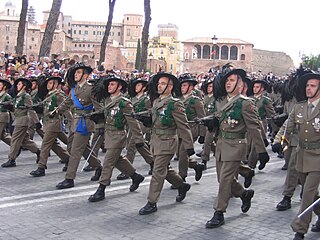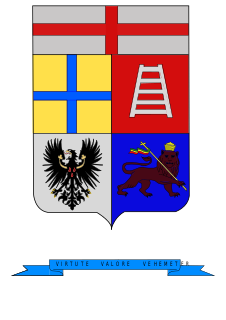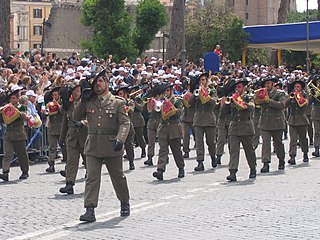
The Bersaglieri, singular Bersagliere,, "sharpshooter") are a speciality of the Italian Army's infantry corps. They were originally created by General Alessandro La Marmora on 18 June 1836 to serve in the Royal Sardinian Army, which later became the Royal Italian Army. They can be recognized by their distinctive wide-brimmed hats decorated with black capercaillie feathers, which is worn with the dress uniform. The feathers are also applied to their combat helmets.

Arditi was the name adopted by a Royal Italian Army elite special force of World War I. Alongside the German Stormtroopers, they were the first modern shock troops, and they have been defined "the most feared corps by opposing armies".

The Comando Truppe Alpine or COMTA commands the Mountain Troops of the Italian Army, called Alpini and various support and training units. It is the successor to the 4º Corpo d'Armata Alpino of the Cold War. The Alpini are light Infantry units specializing in Mountain Combat. The subordinate units of the COMTA distinguished themselves during combat in World War I and World War II.

The XX Army Corps was an corps of the Royal Italian Army during World War II. The Army Corps took part in the Western Desert Campaign from summer 1941 to 1943. Between 10 September 1941 and 10 March 1942 the unit was named Maneuver Army Corps.

Gaetano Giardino was an Italian soldier that rose to the rank of Marshal of Italy during World War I.

The Bersaglieri Brigade "Garibaldi" is a mechanized infantry brigade of the Italian Army, based in the south of the country. Its core units are Bersaglieri, an elite infantry corps of the Italian Army. The brigade is named after Giuseppe Garibaldi a hero of the Italian wars of unification. The brigade is part of the Division "Acqui".

The 3rd Cavalry Division "Principe Amedeo Duca d'Aosta" was a Cavalry or "Celere" (Fast) division of the Royal Italian Army during World War II. The division was formed in 1934, and during World War II was mobilized in June 1940. As a cavalry division it took part in the Invasion of Yugoslavia and was part of the Italian Expeditionary Corps in Russia. Annihilated during the Red Army's Operation Little Saturn in December 1942, the survivors returned to Italy in spring 1943.

The 132nd Armored Brigade "Ariete" is currently the only active armored brigade of the Italian Army. Its core units are tank and Bersaglieri regiments. The brigade's headquarters is in the city of Pordenone and most of its units are based in the North-East of Italy. The brigade's name comes from the battering ram. The brigade draws much of its historical traditions from the 132nd Armored Division "Ariete", which fought in the Western Desert Campaign of World War II. In 1948 the Ariete was reconstituted as division and remained active until 1986. Today the brigade is part of the Division "Vittorio Veneto".

The Mechanized Brigade "Goito" was a mechanized brigade of the Italian Army. Its core units were mechanized Bersaglieri battalions. The brigade's headquarters was in the city of Milan. The brigade's name was chosen in memory of the First Italian War of Independence Battle of Goito, where the Bersaglieri corps had its baptism of fire.

The 3rd Army Corps was one of three corps the Italian Army fielded during the Cold War. Based in the regions of Lombardy and Piedmont the corps was the army's operational reserve, while the 4th Alpine Army Corps and the 5th Army Corps, both based in the North East of Italy, were the army's front-line units. After the end of the Cold War the corps was reduced in size and on 1 December 2000 it ceded its last brigades to the 1st Defence Forces Command. The personnel of the 3rd Army Corps was used to raise the NATO Rapid Deployable Italian Corps in January 2001.

The 5th Army Corps was one of three corps the Italian Army fielded during the Cold War. Based in the regions of Veneto and Friuli-Venezia-Giulia the corps was the army's main combat force. The 5th Army Corps was arrayed close to the Yugoslavian border and tasked with meeting any Warsaw Pact forces that crossed the border. On the left flank of the corps the 4th Alpine Army Corps was tasked with blocking the Alpine passes and in the rear of the corps the 3rd Army Corps served as operational reserve. After the end of the Cold War the corps was reduced in size and on 1 October 1997 it became the 1st Defence Forces Command. In 2013 the COMFOD 1° was disbanded and its function and brigades taken over by the 20th Infantry Division Friuli in Florence.

The 1st Bersaglieri Regiment is an active unit of the Italian Army based in Cosenza in the Calabria region. The regiment is part of the Italian infantry corps' Bersaglieri speciality and operationally assigned to the Bersaglieri Brigade "Garibaldi". The Regiment is among the most experienced units of the Italian Army in missions abroad, and is the regiment with the highest number of decorations for military valour of the army.

Italian Bersaglieri Bands are military bands that belong to the Bersaglieri Corps of the Italian Army. These brass bands are notable for their marching style, playing their instruments while on a jogging pace ahead of their attached units on parade. In the 1800s, every unit in the Bersaglieri had a band known as a "fanfara" or fanfare. Today, this is not the case, with only four Bersaglieri regiments retaining a "fanfara". These bands are the only ones of their kind in the world, another feature is the common performance quick and high tempo marches such as La Marcia dei Bersaglieri, which is the official military march of the Bersaglieri.

The 3rd Bersaglieri Regiment is an active unit of the Italian Army based in Teulada in Sardinia. The regiment is part of the army's infantry corps' Bersaglieri speciality and operationally assigned to the Mechanized Brigade "Sassari". The regiment is the highest decorated unit of the Italian Army with three Gold Medals of Military Valour, two of which the regiment earned during the Italian campaign in Ukraine and Russia in World War II.

The 7th Bersaglieri Regiment is an active unit of the Italian Army based in Altamura in Apulia. The regiment is part of the army's infantry corps' Bersaglieri speciality and operationally assigned to the Mechanized Brigade "Pinerolo".

The 8th Bersaglieri Regiment is an active unit of the Italian Army based in Caserta in Campania. The regiment is part of the army's infantry corps' Bersaglieri speciality and operationally assigned to the Bersaglieri Brigade "Garibaldi". The regiment is one of the highest decorated units of the Italian Army with two Gold Medals of Military Valour, both of which the regiment earned during the North African campaign of World War II.

The 12th Bersaglieri Regiment is an inactive unit of the Italian Army last based in Trapani in Sicily. The regiment is part of the army's infantry corps' Bersaglieri speciality and was last operationally assigned to the Mechanized Brigade "Aosta".

The 26th Bersaglieri Battalion "Castelfidardo" is an inactive battalion of the Italian Army's infantry corps' Bersaglieri speciality. Raised as XXVI Bersaglieri Battalion in 1859 the battalion became autonomous on 15 April 1977 and received the war flag and traditions of the 4th Bersaglieri Regiment of the Royal Italian Army.

The 182nd Armored Infantry Regiment "Garibaldi" is an inactive unit of the Italian Army last based in Sacile in Friuli Venezia Giulia. The regiment was part of the Italian army's infantry and was last operationally assigned to the Infantry Division "Folgore". The regiment was an atypical unit of the Italian Army: formed without a sister regiment from partisan formations it was the only infantry regiment to be formed by the army after World War II and was the only unit, whose members wore a red tie with their formal uniform.
The 8th Marching Division was a short-lived division of the Royal Italian Army during World War II. In the Italian military the term "Marching" refers to temporary units based in Italy to manage replacements for the operational units at the front.



















